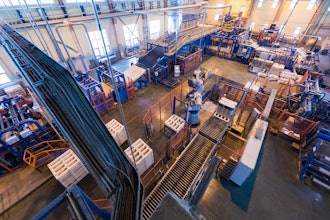
Industrial plant maintenance requires a wide variety of resources, from calibration instruments to high-tech diagnostic equipment. One of the most valuable tools, though, is not housed in the parts storeroom or maintenance garage—it is data. Enterprise data plays a critical role in maintaining plant assets and making strategic decisions about preventative care.
On the other hand, as plants become more dependent on analytics, they often realize the source of data may be flawed and compromised by multiple disparate systems. Data visibility and usability may also be limited, frustrating technicians who need to drill into service histories and risk assessments to complete their tasks. Fortunately, some software providers are responding and striving to make data analytics highly consumable. Self-service reporting and analytics, integration to Geographical Information Systems (GIS), Building Information Modeling (BIM) solutions, and use of Computer Aided Design (CAD) illustrations are changing the way maintenance teams approach data.
What Is at Risk?
It is common to hear plant executives lamenting the current state of their enterprise data. It can be data overload, as their Internet of Things (IoT) initiatives inundate them with raw data points. Or, it can be the questionable reliability of warehouse inventories that is causing worry. Perhaps condition-based assessments have never gotten off the ground because of unanswered questions about remote assets, scattered equipment and legacy plant machinery that belongs in a museum, not a shop floor.
Whatever the reason, once plant executives begin to doubt the enterprise data, regaining credibility and trust is difficult. Data pointing to unpleasant conclusions always seems to be called into question. For example, an investment in a machinery overhaul may have failed to yield the performance expected. Or, a recent repair may have proven to be costlier than the replacement would have been. When this type of bad news jumps off a report, it is human nature to blame the reporting process or cast doubt on the validity of the data.
Nevertheless, this lack of confidence can be costly and lead to overcompensation. In the warehouse, just to be safe, managers may increase inventory safety-stock levels. On the shop floor, aging equipment may be retired prematurely when useful life expectancy still remains. Additionally, managers may opt to replace equipment, rather than repair it, jumping to conclusions that new equipment performs better than repaired equipment, even if data says otherwise.
Improving Trust, Visibility and the Ability to Consume Data
With the increasing complexity of assets and growing demand for higher Overall Equipment Effectiveness (OEE), maintenance teams today must work smarter, not harder. That means turning to data and analytics to focus on ways to save costs, trim inventory investments, anticipate maintenance needs and spot early signs of issues, so major disruptions can be prevented. Even small savings add up. Increasing the efficiency of technicians is especially important, as staffs are often short-handed and struggling to fill open positions.
Maintenance teams can turn to software technology to help them up-level their approach and transition from a reactive business model to a prescriptive one. Here are six ways modern software solutions can help facilitate fact-based decision-making and data-centric strategies.
Integrated Solutions: Deploying a modern Enterprise Asset Management (EAM) solution that integrates with the organization’s Enterprise Resource Planning (ERP) system is the best way to eliminate data discrepancies that can happen when disparate solutions attempt to exchange information. Organizations can turn to a single CloudSuite that includes all of the specific capabilities needed in one system.
Predictive Science: Organizations may choose to leverage Artificial intelligence (AI)-driven analytics to help monitor and predict the failure of the most critical assets, to prevent catastrophic human, environmental or financial loss. In addition to predicting and preventing asset failure, organizations may also envision future trajectories and likely outcomes. These could be maintenance-related essentials such as likely useful lifespan of machinery and likely cadence of maintenance needs, including timing of replacement parts that tend to wear down or need to be replenished. The ability to predict needs with accuracy means necessary spare parts and components can be in-stock, without over-investing in “just-in-case” back-ups.
Mobile Access: Maintenance technicians must be equipped with mobile solutions, so they can access critical asset details when dispatched to remote locations or within the plant. Technicians require access to schematics, as-serviced configurations, prior resolution codes, and if the asset is slated for maintenance, upgrades or retirement. Without access to such information, technicians may be delayed, making unnecessary trips to the tool crib or parts warehouse.
Maps and Drawings: With the wide range of assets that organizations are having to manage today, advanced EAM solutions include integration capabilities with GIS systems so that assets can be tracked on a map. This helps managers and technicians easily see where an asset in question is located. Some organizations might also benefit from integrations with CAD systems to create a visual system to ingest, track and manage equipment structure and hierarchies. A CAD drawing of the asset can also be used as part of the condition-based monitoring system. In other words, the illustration helps the technician see the location of parts and their status. Such applications help the technician visualize complex assets and quickly assess needs.
Report Graphs: Business Intelligence (BI) solutions have changed dramatically in the last five years. Companies “making do” with outdated technology are missing out on the advantages of consumer-like user interfaces. Modern solutions make it easy for users to create charts and graphs from condition-based monitoring. Graphical representations of data points help maintenance teams visualize trends, spot performance anomalies, and hone-in on hot spots with higher than average performance failures.
IoT and Data Lakes: Enterprises can easily become overwhelmed with data when they first launch IoT initiatives to monitor asset performance. The embedded sensors capture and communicate data about the asset’s physical state and monitoring attributes such as temperature or vibration. The data is generated in regular intervals, often every second or minute, so it very quickly becomes a massive amount of information. In addition to observing “good data hygiene”, cloud storage options such as data lakes are making collection and analysis of such large volumes of data possible. In addition to engaging with experienced solution providers, it is also critical for organizations to question their analytics and data strategy.
Final Take-Away
For manufacturing plants to remain competitive, they must optimize their plant operations, making sure all machinery and equipment are running smoothly. Unplanned downtime can be disastrous, causing delays in customer orders and costing millions in lost revenue. Evolving business models are also forcing some manufacturers to own the quality and service of their assets beyond the four walls of their plants.
Therefore, maintenance teams must take advantage of every tool available. Reliable data is one of the most powerful resources to streamline processes and turn reactive business models into prescriptive approaches – and ultimately, allow technicians to manage plant assets with confidence.
Navin Kulkarni is the product director at Infor EAM.























